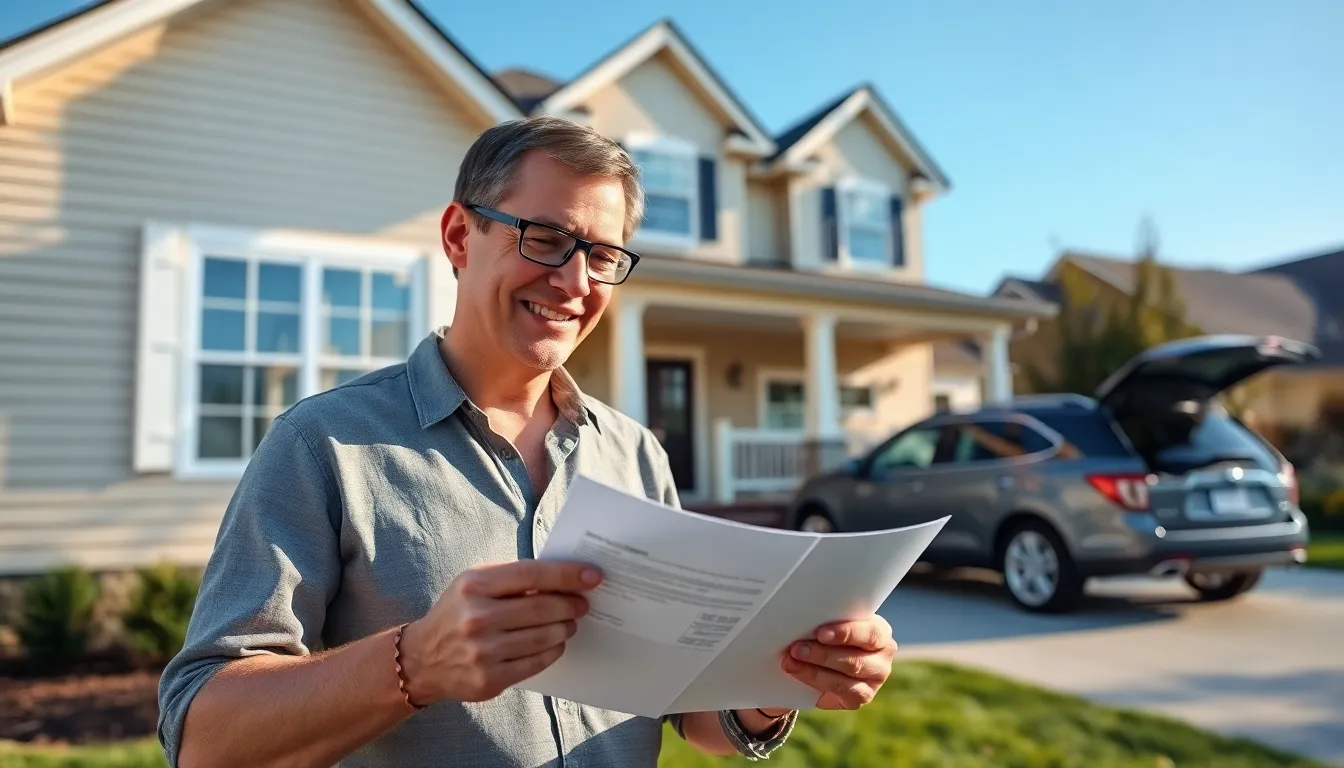Table of Contents
ToggleIn today’s unpredictable world, home insurance has become more essential than ever. With natural disasters, theft, and unexpected accidents lurking around every corner, homeowners need a safety net that provides peace of mind and financial protection. Understanding the intricacies of home insurance can empower homeowners to make informed decisions that safeguard their most valuable asset.
As the landscape of home insurance evolves, it’s crucial to stay updated on the latest trends and coverage options. From customizable policies to innovative technology, the industry is adapting to meet the needs of modern homeowners. This article will explore the current state of home insurance, highlighting key factors that influence coverage choices and tips for maximizing protection. Whether you’re a first-time buyer or looking to reassess your current policy, navigating the world of home insurance has never been more important.
Overview of Home Insurance Today
Home insurance remains a critical component for protecting assets against various risks. The unpredictable nature of events such as natural disasters, theft, and accidents necessitates a comprehensive understanding of available coverage options. Today, homeowners often seek policies that provide financial security and peace of mind.
Current trends indicate a shift towards specialized coverage that addresses modern challenges. Many insurers now offer enhanced policies that cover specific risks like floods, earthquakes, and cyber threats. Such tailored options reflect the diverse needs of homeowners, especially in vulnerable regions.
Key factors influencing coverage choices include geographical location, property type, and individual risk tolerance. Homeowners in areas prone to natural disasters may prioritize comprehensive coverage with higher limits, while others may opt for basic policies that address essential risks.
Maintaining awareness of advancements in home insurance helps homeowners make informed decisions. Staying updated on policy changes, premium rates, and available discounts can lead to better protection and potential savings.
Engaging with agents and comparing multiple quotes enables homeowners to find coverage that aligns with their specific requirements. Understanding the nuances of home insurance empowers individuals to safeguard their investments effectively.
Types of Home Insurance Policies

Understanding the various types of home insurance policies helps homeowners and renters select the best coverage for their needs. Each type of policy addresses specific risks and provides tailored protection.
Homeowners Insurance
Homeowners insurance primarily covers single-family homes and offers protection for the structure, personal property, and liability. Coverage typically includes:
- Dwelling Protection: Covers the home’s structure from damage due to fire, windstorm, and vandalism.
- Personal Property Coverage: Protects belongings within the home, such as furniture and electronics, against theft or damage.
- Liability Coverage: Offers financial protection in case of lawsuits for injuries or damages incurred on the property.
- Additional Living Expenses: Covers temporary living costs while the home is being repaired or rebuilt after a covered loss.
Renters Insurance
Renters insurance provides essential coverage for those who rent apartments or homes. This policy typically includes:
- Personal Property Coverage: Safeguards personal belongings from theft or damage, similar to homeowners insurance.
- Liability Coverage: Protects against claims for injuries or damages to others, including court costs.
- Additional Living Expenses: Covers temporary housing costs if the rental becomes uninhabitable due to a covered event.
Condominium Insurance
Condominium insurance is designed for condo owners and fills the gaps left by the building’s master policy. Key components include:
- Unit Coverage: Protects against damage to the interior of the unit, including walls, floors, and fixtures.
- Personal Property Coverage: Guards personal items within the unit from theft or damage.
- Liability Coverage: Offers protection against lawsuits for injuries or damages occurring within the condo.
- Loss Assessment Coverage: Covers assessments made by the condo association due to damages affecting common areas.
Being informed about these types of home insurance policies allows individuals to choose the most appropriate coverage, aligning it with their specific needs and risks.
Coverage Options and Considerations
Home insurance offers various coverage options essential for protecting property and ensuring financial security. Homeowners must understand these options to select policies tailored to their needs.
Property Coverage
Property coverage protects against damage to the structure and personal belongings within the home. It typically includes dwelling protection, which covers the home’s physical structure, and personal property coverage, which insures personal items like furniture and electronics. Homeowners should assess replacement costs and actual cash value when determining coverage levels. Specialized endorsements, such as those for flood or earthquake protection, cater to additional risks that standard policies may not cover, making them crucial for homeowners in high-risk areas.
Liability Coverage
Liability coverage safeguards homeowners against claims resulting from injuries or property damage incurred on their premises. This type of coverage typically includes legal defense costs, settlements, and medical expenses associated with such claims. Homeowners should consider their risk exposure based on factors like property features and local crime rates. Increasing liability limits or adding umbrella policies can provide extra protection for those with significant assets or higher risk profiles, ensuring comprehensive coverage.
Additional Living Expenses
Additional living expenses (ALE) coverage helps homeowners manage costs incurred when they cannot live in their home due to a covered loss. This coverage typically pays for temporary housing, meals, and other living costs while repairs are completed. Homeowners must evaluate the policy limits and coverage duration, as these can vary between policies. Understanding ALE ensures homeowners maintain financial stability during unforeseen circumstances, allowing them to focus on recovery and repairs without excessive financial strain.
Factors Affecting Home Insurance Premiums
Home insurance premiums vary based on several key factors. Understanding these elements helps homeowners make informed decisions and potentially reduce their costs.
Location
Location significantly influences home insurance premiums. Homes situated in areas prone to natural disasters, such as floods or earthquakes, often incur higher premiums due to the increased risk. Additionally, neighborhoods with high crime rates typically see elevated costs, as insurers account for potential theft or vandalism. Proximity to fire services and hydrants can lower premiums since quick access to emergency resources reduces property damage risks.
Home Value
Home value directly impacts premiums, with higher-valued homes typically commanding larger policies and premiums. Insurers assess the replacement cost, which reflects the amount required to rebuild the home in case of a total loss. Owners of older homes may face higher premiums due to outdated construction materials or systems that may not meet current safety standards, thus posing increased risks. Upgrades and renovations, particularly those enhancing safety and durability, can positively affect premiums by lowering risk profiles.
Claims History
Claims history impacts insurance premiums substantially. Homeowners with a record of frequent claims may find their premiums increased, as insurers view them as higher-risk clients. Even minor claims can affect future rates. Conversely, maintaining a claim-free history can lead to discounts or lower rates, as insurers might classify such homeowners as more responsible and less likely to file claims in the future.
Tips for Choosing the Right Home Insurance
- Assess Coverage Needs: Homeowners should evaluate their specific risks. Identifying local natural disasters or potential accidents can lead to policies with adequate coverage.
- Compare Policy Options: Homeowners must obtain quotes from multiple providers. Reviewing different policies helps ensure selection of appropriate coverage.
- Understand Policy Details: Homeowners should carefully read the terms and conditions. Grasping exclusions, limitations, and deductibles is crucial for informed decisions.
- Consider Replacement Costs: Homeowners need to assess the current market value of their property. Insurance should reflect replacement costs, not just market price, for optimal protection.
- Check for Discounts: Homeowners should inquire about available discounts. Bundling policies, installing security systems, or maintaining a claim-free history can lower premiums.
- Evaluate Customer Service: Homeowners must research provider reviews. Quality of customer service can significantly impact the claims process and overall satisfaction.
- Engage with an Agent: Homeowners should consult with insurance agents for personalized advice. Agents can provide detailed insights into suitable coverage options based on individual needs.
- Review Annually: Homeowners need to reassess their coverage yearly. Changes in property value, personal circumstances, or local risks may necessitate policy adjustments.
- Consider Deductible Levels: Homeowners should determine comfortable deductible amounts. Higher deductibles can lower premiums but may lead to increased out-of-pocket expenses during claims.
- Ask About Endorsements: Homeowners must explore endorsements for additional coverage. Specific threats, like floods or earthquakes, require specialized policies to ensure comprehensive protection.
Home insurance is more than just a policy; it’s a crucial safeguard for homeowners in an ever-changing world. With the right coverage, individuals can protect their investments and ensure peace of mind against unforeseen events.
Staying informed about trends and options empowers homeowners to make decisions that align with their unique needs. By understanding the various types of policies and coverage available, they can tailor their insurance to provide comprehensive protection.
Regularly reviewing coverage and engaging with knowledgeable agents can lead to better choices and potential savings. Homeowners who prioritize their insurance needs will find themselves better equipped to face whatever challenges may come their way.




